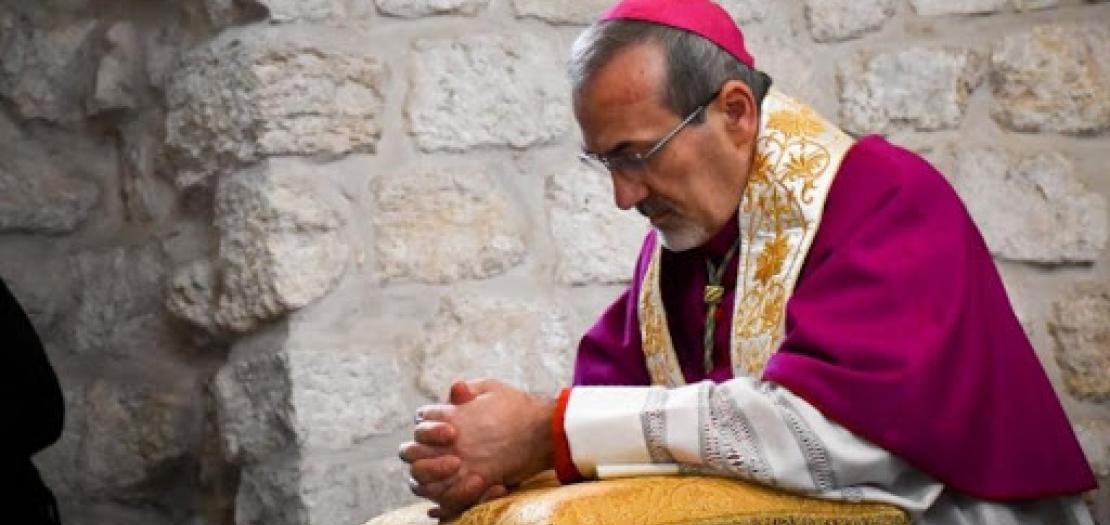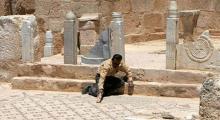Issued by the Catholic Center for Studies and Media - Jordan. Editor-in-chief Fr. Rif'at Bader - موقع أبونا abouna.org

Following is the meditation of Latin Patriarch of Jerusalem His Beatitude Pierbattista Pizzaballa for the second Sunday of Ordinary Time, Year B, 2021, January 17, 2021:
We are still on the banks of the Jordan, where John continues to baptize.
The Gospel says that “John was still standing there” (Jn 1:35), and it seems as if he will remain there until his stay does not produce a movement. Movement is not his to do (his task is “only” to prepare and testify to the coming of the Messiah), but his disciples.
The Gospel passage of today, sure enough, says that John was there with two of his disciples and that, from now on, they are no longer with him. Now, they follow Jesus. The Baptist will return to the stage in Chapter 3 (23-30), just to say that it is time to disappear, to decrease. If the expected-One has come, if “all run towards Him” (Jn 3:26), and if even John’s disciples start following Him, then his mission is indeed complete.
What begins, then, is the way of discipleship, and it starts with its two characteristic expressions: listening and following (Jn 1:37). The disciple is one who takes on an attitude of listening and receiving. Listening is a style of being in the world, of those who do not live by their self, but by what has been given to them. Those who listen are aware of receiving life from others.
But it’s not enough to listen only: we are disciples when listening begets a movement, an action; when what we’ve heard moves us to walk behind the One Who speaks to us; when it causes us to go to Him when it gives birth to a relationship.
We will again find these two expressions in Chapter 10, the chapter of the Good Shepherd: “My sheep listen to my voice, and I know them, and they follow me. I give them eternal life” (Jn 10:27-28).
Jesus directs a fundamental question to the two disciples that follow Him: “What are you looking for?” (Jn 1:38). These are Jesus’ first words in the Gospel of Saint John.
It’s as if Jesus asked them to focus on the starting point, the desire that moves them, the fire that drives them. It’s to pinpoint the deficiency that each one has within, and that pushes one not to be content with what one already has, with what one already knows, and what one already loves. The one who is aware and who sees that we made for an eternal beyond and that this beyond must be sought and awaited because it can only be given to us is the one who understands Jesus’ question.
With such a question, Jesus also tells us that the One who they are beginning to follow is a God who lets Himself to be pursued, and who is not impossible to find. Indeed, He is the One, in turn, seeking man, as we will see shortly with Peter. Jesus does not ask more, He does not ask for other credentials, except to find within oneself one’s most profound desire.
With a question, the two disciples, are expressing extraordinarily what this deep desire is: “Master, where do you live?” (Jn 1:38). The desire is a question, and a question about a place, about a house where to live with someone.
The disciples of the rabbis at that time often went to the house of their masters, to learn by living, by sharing life, and the art of wisdom in which their masters were experts. It is necessary to know where the teacher lives, to be able to search and find him. It is the experience of so many pilgrims who come here from the world over to see where Jesus lived.
Thus, it’s for everyone: the more genuine desire, which we carry within, is that of being with Him; of knowing for sure that we can find Him, that there is a place in our life, where He is always waiting to be with us.
Jesus’ answer is not obvious; He does not give them an address, but a path on which to walk together: “Come and see” (Jn 1:39). The place to look for Him is itself the outcome; it’s the walking behind Him: there is no other place to know Him, where to stay together with Him (Jn 1:39).
Whoever listens and follows, in turn, becomes a witness, as the Baptist was: the power of attraction that he experienced in himself, the fascination of the words that immediately lead to the essential thing become in turn an attraction for others.
John’s Gospel presents other passages where those who have listened and believed become in turn instruments of salvation for others, who through them come to faith. It’s the case of the Samaritan woman (Jn 4), who leaves the pitcher and runs to the village to tell about finding Someone who spoke new words to her, different words from those she heard up to that time.
It’s here that the disciple Andrew became a witness. As soon as he meets his brother he cannot but share with him the discovery he made and the new life generated in him (Jn 1:40-42). And going with him to Jesus, he discovers that He, the Master, first knows them: “Fixing his gaze on him, Jesus says: “You are Simon, son of John; you will be called Cephas” – which means Peter” (Jn 1:42). Jesus sees Peter, and changes his name. It’s symbolic of a new mission that the Lord will entrust to him. And it’s also emblematic of that radical change of life that invests every disciple who risks, and who agrees to leave everything else to listen to his most authentic desire, staying with the Lord. Indeed, this changes a life.
+ Pierbattista







